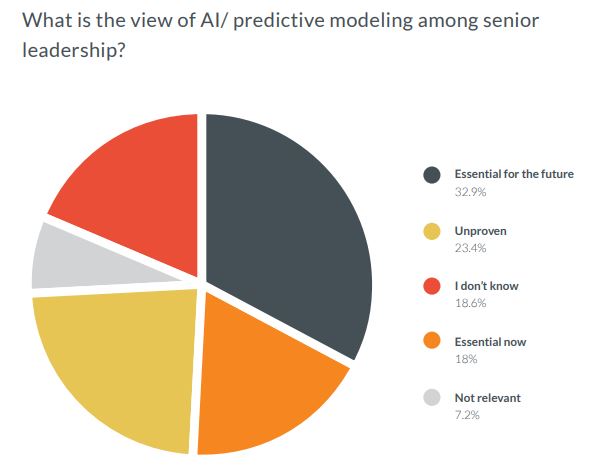Things may seem slow during these hot summer months, but fall will be here in just over eight weeks, followed by the holidays, then a brand-new year.
That makes now an excellent time to begin building a marketing strategy for 2020 using data gleaned from the first two quarters of 2019. While the wealth of data collected from your existing marketing efforts can help you understand what’s worked in the past, it won’t necessarily help you predict what to do in the future.
That’s where predictive modeling comes in. Predictive modeling uses historical data and probability to forecast outcomes. Platforms like Keen Decision Systems provide real-time analytics and data modeling that help marketers plan their next steps based on the entire customer journey.
Content produced in collaboration with Keen Decision Systems.
Making good marketing decisions
In a collaborative study between ClickZ and Keen, 58% of marketers using predictive modeling experienced a 10-25% uplift, while another 19% saw more than a 50% uplift.
Analytics and marketing platforms help with the collection, categorization and reporting of data, but does this make it predictive? Nearly half of marketers surveyed answered “no” to this question.

The problem is that while campaign (and other) data can be extremely useful for reporting and analysis, it’s typically not used to provide future direction on how to optimize investments to drive growth.
Data stuck in a spreadsheet or static report isn’t actionable. This can make for slow or poor decision-making when you sit down to create next year’s marketing plan.
When embarking on next year’s planning, it’s obviously much more valuable to know what to do next than simply to understand what’s worked in the past.
Why predictive modeling is better for planning than retroactive analysis
For today’s marketers, the most important (Read more...) to solve is knowing the financial output of their marketing investments, and being able to demonstrate those outputs in a quantifiable, predictable way.
Within that overarching goal, marketers should look at:
Whitepapers
- The customer journey across channels, and the role specific play in conversion
- Optimizing media investments, and knowing the incremental lift of each initiative
- How to execute quickly and assess performance

These needs aren’t being met by the current model of retroactive analysis, as evidenced by the fact that nearly 80% of Keen/ClickZ survey respondents felt they’d missed opportunities because of slow or inaccurate decision making.
Traditional reporting methods struggle to provide a deep understanding of all three business needs because they use linear-attribution approaches that can’t span all channels (e.g., online video vs. store-level programming). This tends to give most or all of the credit to last-click media channels such as search, as well as to transactional activities with measurable short-term impact, both of which tell only part of the story.
Predictive modeling also helps with creative optimization by looking at what common themes drive success across all media types.
Barriers to entry
More than 70% of respondents indicated they use analytics platforms to understand marketing performance. Since analytics tools are historically focused, they fail at the task of reliable planning.
Two-thirds of survey respondents indicated they don’t use any form of predictive modeling at all. For those who do, certain industries stand out more than others; namely, technology, healthcare, and communications/media.
At present, there is a widespread lack of intent to invest in predictive modeling technology among respondents, with the majority of companies that don’t currently use modeling indicating they’re unsure about using it in the future (or aren’t planning on using it at all).
The main barrier to usage appears to be a lack of confidence among senior leadership teams, with just 18% responding that predictive modeling is essential right now and about 33% indicating it will be essential in the future.

For modeling to be effective it needs to integrate data from marketing, sales, product and finance teams. Yet, 74% of respondents indicated they haven’t integrated predictive modeling across all departments.
Companies need to apply cross-functional engagement across the entire organization or the predictive value of the data will be diminished.
Predictive modeling as an investment
For 80% of survey respondents, the main selling point for implementing predictive analytics is to increase their ROI. Among companies that currently invest in predictive modeling and track their success, 58% saw a 10-25% uplift in ROI and 19% saw a more than 50% uplift.
Companies that utilize predictive modeling see an impact across multiple areas of the marketing ecosystem. It helps them understand their target audience better (71%), optimize all touchpoints along the customer journey (53%), and improve creative performance (44%).

Predictive models utilize a variety of data sets that go beyond historical data. Keen uses a base of statistical priors to mitigate data quality and layers in sales and financial data to determine future outcomes.
Predictive modeling also can help businesses synthesize the sheer volume of data, a key concern for respondents, with 38% indicating their current measurement solutions do not support the scale of their data. This can prevent businesses from making informed, timely decisions, which equates to lost opportunity.
Since predictive modeling allows for real-time data analysis, businesses can act swiftly using current data to help plan future initiatives.
For more information about predictive modeling and what it can deliver to your 2020 planning cycle, download ClickZ and Keen’s report “The what, why, and how of predictive modeling — Do you really need another piece of martech?”
